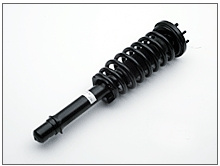SHOWA


Showa Automotive Shock Absorbers Steering Systems Differential Gears Propeller Shafts Gas Springs Motorcycle Outboard
The shock absorber is installed between the car body and the tire, along with a spring. The spring that serves to damp shocks is referred to as a "shock absorber," and its viscous resistance force is referred to as "damping force."
Shock absorbers are a critical product that determines an automobile's character, not only by improving ride quality but also by functioning to control the attitude and stability of the automobile body.
SHOWA's Approach
SHOWA develops lightweight dampers using high-tension materials to improve ride quality and fuel performance. We also develop oil seals that control resistance during damper operation. Based on the functional integration of advanced performance of each component part, SHOWA develops suspension modules for high-added value.
Forms of Suspensions and Types of Shock Absorbers
Showa Double-wishbone
|
Double-tube: The outer part of the double tube is used as a gas chamber, which is filled with low- pressure nitrogen gas. This type can provide stable damping force. |
|
Single-tube: Separation between oil and nitrogen gas by a free piston provides stable damping force, as well as high performance. |
Showa Strut
|
Double-tube: This type consists of double tubes that comprise part of the support structure of the suspension. Filled with low-pressure nitrogen gas, it provides stable damping force. |
|
Inverted type: Structurally, this is a single-tube type placed upside down. Its large-diameter pipe provides sufficient rigidity to bear the heavy load from the car body, characteristic of a strut. |
Showa Type with separately mounted spring (rigid axle, etc.)
|
Unit damper: Because the spring is mounted separately, this type features a simple structure comprised of a damping mechanism only. |

